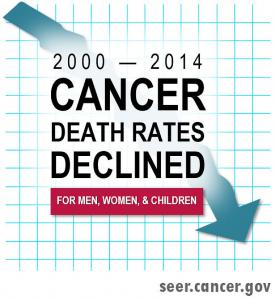Annual Report to the Nation: Cancer Death Rates Continue to Decline
Special section on survival finds significant improvement for all but two cancer sites.
Overall cancer death rates continue to decrease in men, women, and children for all major racial and ethnic groups, according to the latest Annual Report to the Nation on the Status of Cancer, 1975-2014. The report finds that death rates during the period 2010-2014 decreased for 11 of the 16 most common types of cancer in men and for 13 of the 18 most common types of cancer in women, including lung, colorectal, female breast, and prostate cancers. Meanwhile, death rates increased for cancers of the liver, pancreas, and brain in men and for liver and uterine cancer in women. The report finds overall cancer incidence rates, or rates of new cancers, decreased in men but stabilized in women during the period 1999-2013.

The Report to the Nation is released each year in a collaborative effort by the American Cancer Society; the Centers for Disease Control and Prevention (CDC) and the National Cancer Institute (NCI), both parts of the Department of Health and Human Services; and the North American Association of Central Cancer Registries (NAACCR).
The report appears early online in the Journal of the National Cancer Institute (JNCI) and includes a special section, which this year focuses on survival expressed as percentage. It finds that several but not all cancer types showed a significant improvement over time for both early- and late-stage disease, and varied significantly by race/ethnicity and state.
“While trends in death rates are the most commonly used measure to assess progress against cancer, survival trends are also an important measure to evaluate progress in improvement of cancer outcomes,” said Ahmedin Jemal, D.V.M., Ph.D., of the American Cancer Society and lead author of the study. “We last included a special section on cancer survival in 2004, and as we found then, survival improved over time for almost all cancers at every stage of diagnosis. But survival remains very low for some types of cancer and for most types of cancers diagnosed at an advanced stage.”
Compared to cases diagnosed in 1975-1977, five-year survival for cancers diagnosed in 2006-2012 increased significantly for all but two types of cancer: cervix and uterus. The greatest absolute increases in survival (25 percent or greater) were seen in prostate and kidney cancers as well as non-Hodgkin lymphoma, myeloma, and leukemia.
Overall cancer death rates continue to decrease in men, women, and children for all major racial and ethnic groups, according to the latest Annual Report to the Nation on the Status of Cancer, 1975-2014. The report finds that death rates during the period 2010-2014 decreased for 11 of the 16 most common types of cancer in men and for 13 of the 18 most common types of cancer in women, including lung, colorectal, female breast, and prostate cancers. Meanwhile, death rates increased for cancers of the liver, pancreas, and brain in men and for liver and uterine cancer in women. The report finds overall cancer incidence rates, or rates of new cancers, decreased in men but stabilized in women during the period 1999-2013.
The Report to the Nation is released each year in a collaborative effort by the American Cancer Society; the Centers for Disease Control and Prevention (CDC) and the National Cancer Institute (NCI), both parts of the Department of Health and Human Services; and the North American Association of Central Cancer Registries (NAACCR).
The report appears early online in the Journal of the National Cancer Institute (JNCI) and includes a special section, which this year focuses on survival expressed as percentage. It finds that several but not all cancer types showed a significant improvement over time for both early- and late-stage disease, and varied significantly by race/ethnicity and state.
“While trends in death rates are the most commonly used measure to assess progress against cancer, survival trends are also an important measure to evaluate progress in improvement of cancer outcomes,” said Ahmedin Jemal, D.V.M., Ph.D., of the American Cancer Society and lead author of the study. “We last included a special section on cancer survival in 2004, and as we found then, survival improved over time for almost all cancers at every stage of diagnosis. But survival remains very low for some types of cancer and for most types of cancers diagnosed at an advanced stage.”
Compared to cases diagnosed in 1975-1977, five-year survival for cancers diagnosed in 2006-2012 increased significantly for all but two types of cancer: cervix and uterus. The greatest absolute increases in survival (25 percent or greater) were seen in prostate and kidney cancers as well as non-Hodgkin lymphoma, myeloma, and leukemia.
Source: U.S. National Cancer Institute
- 263 reads
Human Rights
Ringing FOWPAL’s Peace Bell for the World:Nobel Peace Prize Laureates’ Visions and Actions

Protecting the World’s Cultural Diversity for a Sustainable Future

The Peace Bell Resonates at the 27th Eurasian Economic Summit

Declaration of World Day of the Power of Hope Endorsed by People in 158 Nations

Puppet Show I International Friendship Day 2020

